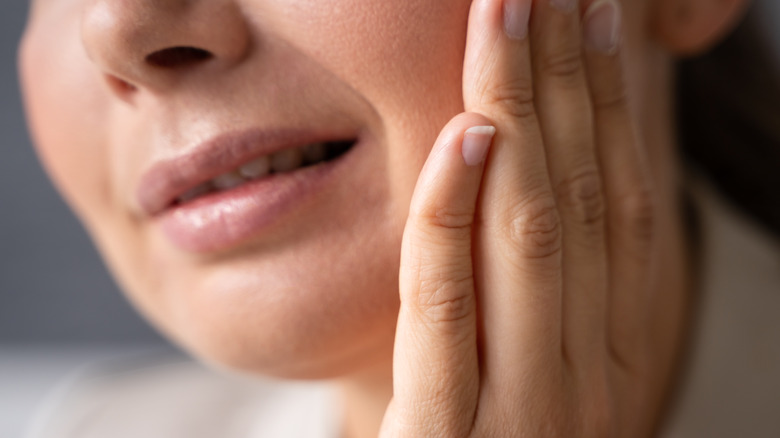What It Means If You Have Black Gums
If you've ever noticed a change in the color of your mouth, it may be from simply having eaten a handful of colorful Skittles or sipping on a bright blue slushy. But what about changes in the color of our gums? Factors such as race, ethnicity, or health status will influence the color of one's gums (Valley Dental Care). Healthy gums may appear dark brown for those whose bodies contain more melanin (via Center for Advanced Periodontal & Implant Therapy). Alternatively, healthy gums may also appear somewhat red, pink, or vaguely pale in color around the gum line.
In some cases, however, our gums may take on a different color as a result of certain health conditions. Examples include gingivitis, if gums become significantly red. Alternatively, overly-pale gums may point to a vitamin deficiency, while purple gums may potentially be a sign of cardiovascular disease. But what about black gums?
If you notice portions of your gums are taking on a black hue, it might seem a little alarming at first. However, this change in gum color can mean a variety of things and is not always a reason to panic.
Why adults or children may develop black spots on gums
As mentioned, gum color can vary from person to person and it is not always indicative of a health condition. Similar to having dark brown gums, for example, people whose bodies have more melanin may naturally have black gums, according to the Center for Advanced Periodontal & Implant Therapy. Similarly, some people may have melanotic macules on their gums, which are small, benign, hyper-pigmented spots where the body is producing more melanin (via Brigham and Women's Hospital ).
In other cases, a person might notice the emergence of new black spots on their gums. However, the cause may be relatively minor. For instance, if a particular area of the gums turns black, it may potentially be a bruise related to a mild injury, says Jefferson Dental & Orthodontics. In this case, the discoloration should resolve itself as it heals. Another potential cause may be a blue nevus. Not considered dangerous, these small moles can show up as tiny black dots on the gums. Also harmless is what's known as an amalgam tattoo. An amalgam tattoo occurs when the metal materials used in a crown or filling gets stuck underneath the gums, leaving a black or blue stain.
Alternatively, for young children, the appearance of black spots on the gums is not uncommon during the teething process when new teeth are making their way to the surface and gums can subsequently become discolored (via BriteGums).
More serious causes of black gums
In some instances, gums that turn black in color may point to a more serious medical condition. This can include a genetic condition known as Peutz-Jeghers Syndrome, in which dark-colored freckles may appear on the gums starting at a young age but then go away as one enters adulthood, as per a 2008 review in Romanian Journal of Morphology and Embryology. While benign, the condition may make an individual more susceptible to cancer. Alternatively, the development of dark patches on the gums may be a symptom of Addison's disease, a rare condition in which the adrenal glands' ability to produce hormones is diminished (via Center for Advanced Periodontal & Implant Therapy).
Also referred to as trench mouth, acute necrotizing ulcerative gingivitis is a bacterial infection that can also prompt black or grey discoloration on the gums due to an accumulation of dead tissue. The condition can often be treated with antibiotics. Lastly, the development of black spots on one's gums can potentially be a warning sign of oral cancer. Consult with your doctor who will be able to offer a formal diagnosis and explore treatment options depending on whether the cancer has spread.



